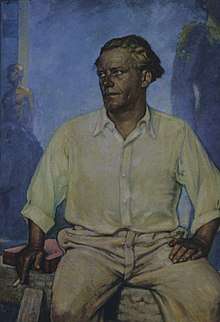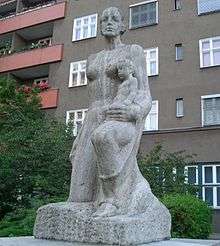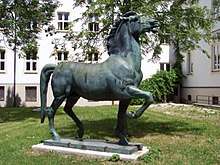Josef Thorak
Josef Thorak (7 February 1889 in Salzburg, Austria – 26 February 1952 in Hartmannsberg, Bavaria) was an Austrian-German sculptor. He was well known for his "grandiose monuments".[1]


Life and career
Thorak's reputation was established in 1922 when he created Der sterbende Krieger (The Dying Warrior), a statue memorializing the dead of World War I in Stolpmünde.
In 1933, Thorak joined Arno Breker as one of the two "official sculptors" of the Third Reich.[2] In his government-approved studio outside Munich, Thorak worked on statues intended to represent the folk-life of Germany under Nazi leadership; these works tended to be heroic in scale, up to 20 metres (65 feet) in height. His official works from this period included a number of sculptures at the Berlin Olympic Stadium of 1936. His work was also part of the sculpture event in the art competition at the 1932 Summer Olympics.[3]
Albert Speer referred to Thorak as "more or less my sculptor, who frequently designed statues and reliefs for my buildings" and "who created the group of figures for the German pavilion at the Paris World's Fair.[4] His statue Comradeship stood outside the pavilion, depicting two enormous nude males, clasping hands and standing defiantly side by side, in a pose of racial camaraderie.[5]
Because of his preference for muscular neo-classical nude sculpture, Thorak was nicknamed "Professor Thorax".[6] Some expressionist influences can be noticed in his generally neoclassical style.
Reich Chancellery's striding horses

_Thorak_cropped.jpg)
On 20 May 2015, two of Thorak's sculptures, a pair of colossal "striding horses" that had once stood outside the Reich Chancellery built by Albert Speer in Berlin, turned up during a police raid on a storehouse in Bad Dürkheim, along with other Nazi art. The horses had disappeared in 1989 from a barracks ground in Eberswalde northeast of Berlin, where they had sat since sometime after the Second World War.[7]
The Third Thorak Horse was Displayed in 1939 in room 2, the "Skulpturensaal" of the Haus der Deutschen Kunst in Munich. In August 2015, this sculpture was rediscovered at the school yard of the boarding school "Landschulheim Schloss Ising" in Ising on Chiemsee, Bavaria. In 1961, Thorak's widow used the sculpture to pay tuition fees for her son's education at the school.
See also
References
- Rhodes, Anthony, ‘’Propaganda: The Art of Persuasion: World War II’’ Chelsea House Publishers, New York, 1976 , p. 28
- "Art: Bigger Than Life"
- "Josef Thorak". Olympedia. Retrieved 8 August 2020.
- Speer, Albert, Spandau: the Secret Diaries’’, Macmillan Publishing Co., Inc. New York, 1976, p. 261
- Richard Overy, The Dictators: Hitler's Germany, Stalin's Russia, p260 ISBN 0-393-02030-4
- F.K.M. Hillenbrand, Underground Humour in Nazi Germany (Routledge 1995), p. 105 ISBN 0-415-09785-1
- "Verschollene Nazi-Kunst entdeckt" Frankfurter Allgemeine Zeitung, 20 May 2015 — Article about Nazi art found in police raid in Bad Dürkheim